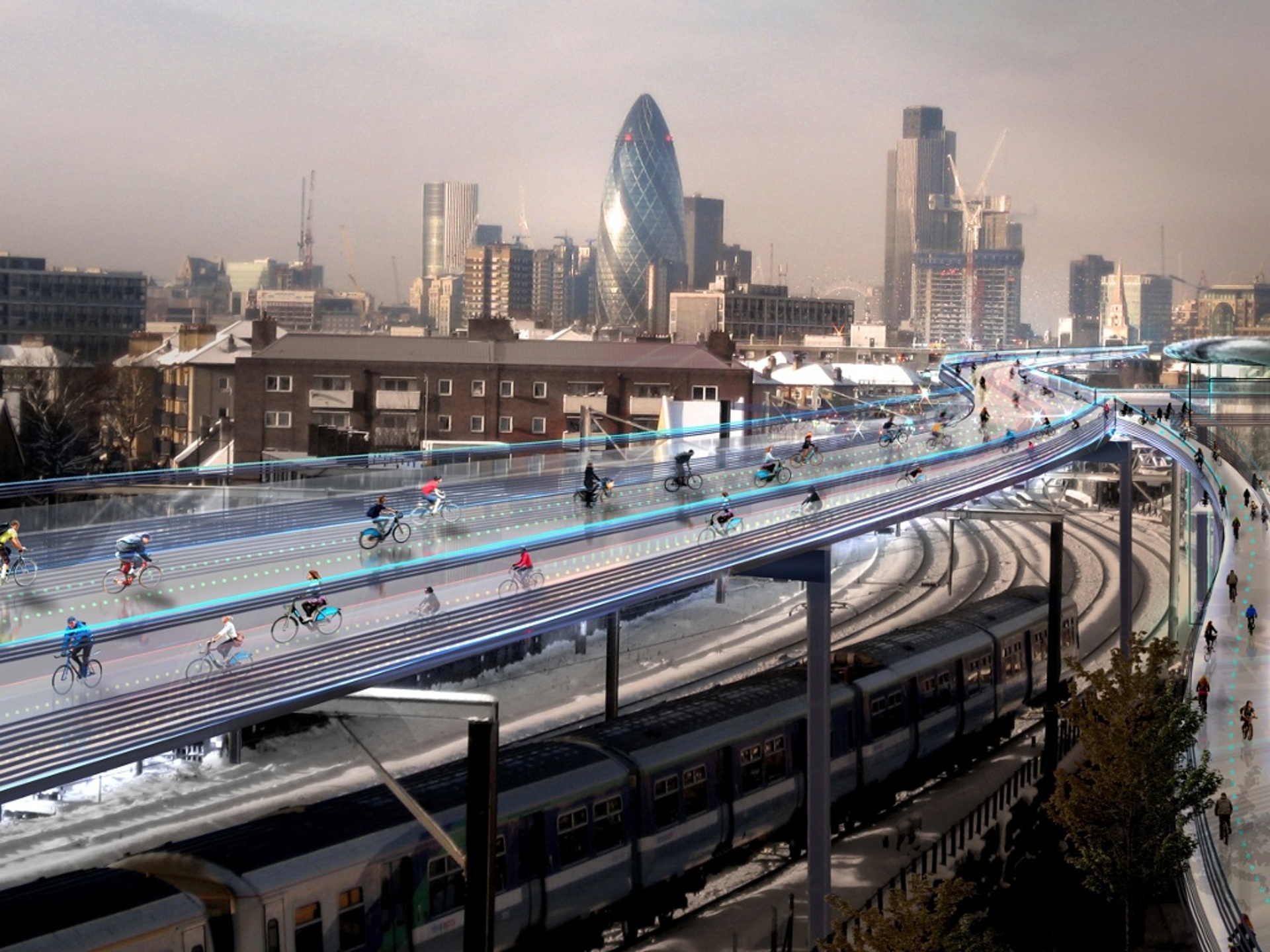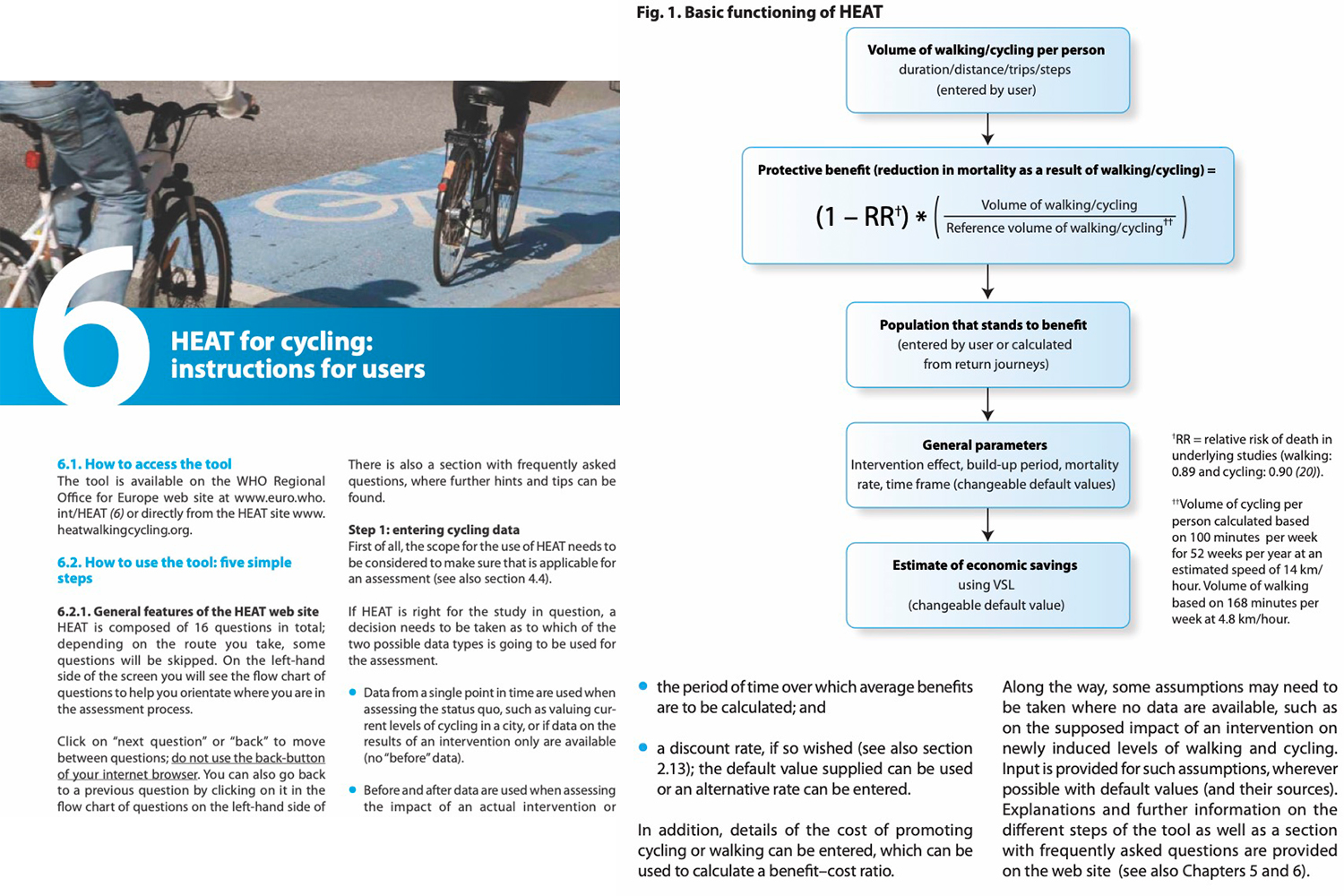“How do we reuse precious existing infrastructure?”
The SuperBikeway










“We need a way for cyclists to travel long distances on highways exclusively for them.”
For Hey Brooklyn: Move to Detroit, (1) we worked with the talented Paul Mosely and the industrious Michael Genge to rethink and reappropriate Chicago’s 19th century transportation networks for the 21st century in two parts.
First, we were inspired by Norman Foster’s conceptual bicycle highway (2), which put cyclists atop concrete stilts to cut through the center of London. The core idea is that bicycle riders benefit from unobstructed rides through the city. Cyclists could travel at high speeds without intersections with autos nor pedestrians. It is a fantastic idea for both personal fitness and the health of the planet. How realistic is it? Considering that major American mass transit infrastructure projects like Chicago’s north side Red Line Rebuild costs $1 billion per mile, it is less than likely to be built.
A RESILIENT CITY TRANSFORMS OBSOLETE INFRASTRUCTURE INTO USEFUL INFRASTRUCTURE (The Fordist City Endures) (3)
Chicago is and will always be the primary interior nodal point in the great American logistics network. It is a Fordist city.The city boomed from 4,000 residents the time of its incorporation in 1837 to a million 50 years later. Chicago has a tremendous amount of unused transportation infrastructure. (4) It had the world’s largest cable car network from 1882 until 1903 when a faster street car network replaced it. Chicago was and is the nation’s railroad hub. In 1893, after 1,700 people died in accidents at railroad crossings, the city council mandated that all rail lines with the city limits be raised. A huge private works project raised over two thousand miles of tracks so pedestrians and vehicles could pass unimpeded. (5) Many lines such as the Union Pacific North once had three tracks and now have only two. We propose filling the empty third slot of the UP-North line with a bicycle Superhighway. A rider can begin in the suburb of Wilmette and ride the 17 miles downtown without crossing paths with a single car or pedestrian. (6,7)(Most people surveyed say they would cycle more if there were no cars.) (A seasoned commuter cyclist could cover this distance in 40 minutes. Bicycling’s health benefits as laid out by the World Health Organization’s Heat Assessment Tool (HEAT) state that 120 hours of cycling provides an estimated protective benefit of 14% less mortality compared to persons not cycling regularly. (8) People live longer and are more productive and healthy. This is the cold math of Taylorism or Fordism. Given the raised infrastructure already exists, the feasibility of the SuperBikeway is great compared to the more pie-in-the-sky Norman Foster scheme. The demonstrated health and economic benefits make the SuperBikeway a compelling value proposition in the Fordist town that is Chicago.
Second, obsolescence makes many nineteenth century railroad yards redundant and Paul and I played around with the challenge of how to reimagine them based upon Italian and Roman precedents. What happens to the Fordist Inner City when the factories are gone and the supply chains move to the exurbs? There is Taylorism or Fordism and then the rhetoric of it. There’s the tradition of drawing Rome in terms of poché, layers, excavation and appropriation. The Italian Architect Aldo Rossi, hands down my favorite post-modern architect, said the building type endures. His most famous example, the Amphitheater in the center of Lucca (9), was quarried for its stones, and disappeared save for the circular outlines of its stage. It endures as Lucca’s town center, now framed by buildings built up the foundations of the viewing stands. That’s what we tried to visualize in our poché renderings of Chicago’s old railroad yards. (10)
#makenolittleplans #danielburnham #normanfoster #cityplanning #transportationplanning #cycling #architecture #dezeen #archpaper #2030 #zerocarbon #aldorossi #makearchitecture #acsa #uvaschoolofarchitecture #lorilightfoot #wewillchicago #wildmile #edgewaterchamberofcommerce #MauriceDCox #future #2030plan #DCAPChicago #DCAP #fordism
For Hey Brooklyn: Move to Detroit, (1) we worked with the talented Paul Mosely and the industrious Michael Genge to rethink and reappropriate Chicago’s 19th century transportation networks for the 21st century in two parts.
First, we were inspired by Norman Foster’s conceptual bicycle highway (2), which put cyclists atop concrete stilts to cut through the center of London. The core idea is that bicycle riders benefit from unobstructed rides through the city. Cyclists could travel at high speeds without intersections with autos nor pedestrians. It is a fantastic idea for both personal fitness and the health of the planet. How realistic is it? Considering that major American mass transit infrastructure projects like Chicago’s north side Red Line Rebuild costs $1 billion per mile, it is less than likely to be built.
A RESILIENT CITY TRANSFORMS OBSOLETE INFRASTRUCTURE INTO USEFUL INFRASTRUCTURE (The Fordist City Endures) (3)
Chicago is and will always be the primary interior nodal point in the great American logistics network. It is a Fordist city.The city boomed from 4,000 residents the time of its incorporation in 1837 to a million 50 years later. Chicago has a tremendous amount of unused transportation infrastructure. (4) It had the world’s largest cable car network from 1882 until 1903 when a faster street car network replaced it. Chicago was and is the nation’s railroad hub. In 1893, after 1,700 people died in accidents at railroad crossings, the city council mandated that all rail lines with the city limits be raised. A huge private works project raised over two thousand miles of tracks so pedestrians and vehicles could pass unimpeded. (5) Many lines such as the Union Pacific North once had three tracks and now have only two. We propose filling the empty third slot of the UP-North line with a bicycle Superhighway. A rider can begin in the suburb of Wilmette and ride the 17 miles downtown without crossing paths with a single car or pedestrian. (6,7)(Most people surveyed say they would cycle more if there were no cars.) (A seasoned commuter cyclist could cover this distance in 40 minutes. Bicycling’s health benefits as laid out by the World Health Organization’s Heat Assessment Tool (HEAT) state that 120 hours of cycling provides an estimated protective benefit of 14% less mortality compared to persons not cycling regularly. (8) People live longer and are more productive and healthy. This is the cold math of Taylorism or Fordism. Given the raised infrastructure already exists, the feasibility of the SuperBikeway is great compared to the more pie-in-the-sky Norman Foster scheme. The demonstrated health and economic benefits make the SuperBikeway a compelling value proposition in the Fordist town that is Chicago.
Second, obsolescence makes many nineteenth century railroad yards redundant and Paul and I played around with the challenge of how to reimagine them based upon Italian and Roman precedents. What happens to the Fordist Inner City when the factories are gone and the supply chains move to the exurbs? There is Taylorism or Fordism and then the rhetoric of it. There’s the tradition of drawing Rome in terms of poché, layers, excavation and appropriation. The Italian Architect Aldo Rossi, hands down my favorite post-modern architect, said the building type endures. His most famous example, the Amphitheater in the center of Lucca (9), was quarried for its stones, and disappeared save for the circular outlines of its stage. It endures as Lucca’s town center, now framed by buildings built up the foundations of the viewing stands. That’s what we tried to visualize in our poché renderings of Chicago’s old railroad yards. (10)
#makenolittleplans #danielburnham #normanfoster #cityplanning #transportationplanning #cycling #architecture #dezeen #archpaper #2030 #zerocarbon #aldorossi #makearchitecture #acsa #uvaschoolofarchitecture #lorilightfoot #wewillchicago #wildmile #edgewaterchamberofcommerce #MauriceDCox #future #2030plan #DCAPChicago #DCAP #fordism